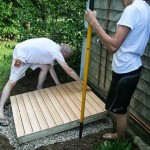Wood Handrails for Outdoor Steps: Enhancing Safety and Style
Outdoor steps, while adding functionality and visual appeal to a property, can also present safety hazards. A thoughtfully designed and expertly crafted handrail can significantly mitigate those risks, offering vital support for ascending and descending the steps. While various materials are available, wood handrails remain a popular choice for outdoor applications, blending seamlessly with natural surroundings and adding a touch of timeless elegance.
Durability and Longevity
Wood handrails are renowned for their durability and longevity, especially when sourced from robust and weather-resistant species. Cedar, redwood, and teak are commonly favoured for their natural oils that repel moisture and resist decay. These woods can endure the harsh elements, including rain, snow, and sun exposure, making them ideal for outdoor use. Proper maintenance, such as regular cleaning and oiling, can further enhance their lifespan.
When selecting wood for handrails, consider factors like the climate, intended use, and aesthetic preferences. For instance, a redwood handrail may be suitable for a coastal setting, while teak might be ideal for a hot and humid climate. Always consult with a professional to get expert advice on the best wood species for your specific needs.
Versatility and Design Options
Wood handrails offer immense versatility in design, allowing for seamless integration with various architectural styles. From traditional to modern, simple to ornate, the possibilities are virtually limitless. The choice of wood species, finish, and design elements like spindles, balusters, and newels can dramatically impact the overall aesthetic and complement the existing landscape.
Straight handrails are commonly used for straightforward stairways, while curved handrails can add elegance and sophistication to winding staircases. The integration of decorative elements, such as carvings or scrollwork, can further enhance the visual appeal, creating a unique and eye-catching feature.
Enhanced Safety and Accessibility
The primary function of a handrail is to provide safety and accessibility for people of all ages and abilities. A sturdy and properly installed handrail can help prevent falls, particularly for elderly individuals, children, and those with mobility challenges. This critical safety feature enhances the functionality and overall convenience of outdoor steps.
Handrails also serve as a guide, providing stability and balance when navigating uneven surfaces. They can be particularly beneficial for steps with varying lengths or those situated on inclines. By ensuring secure and comfortable use, handrails promote an inclusive and accessible environment for all.
When designing and installing handrails, it is vital to comply with relevant safety standards and building codes. These regulations specify aspects like handrail height, diameter, and spacing to ensure optimal functionality and safety.
Wood handrails can be customized to suit specific needs, offering a range of options for functionality and aesthetics. Factors like length, height, and design elements can be tailored to the specific dimensions and requirements of the steps, ensuring a perfect fit and a safe and stylish addition to any outdoor space.

Outdoor Handrail Wood 8 Steps For Deck Stairs

Simple Exterior Handrail For Less Than 100 6 Steps With S Instructables

Freestanding Outdoor Stairs With Wooden Handrail Rounded Top

Nice Look With Metal Contrast Give A Professional Finish This Would Really At Front Door W Deck Stair Railing Outdoor Stairs

Porch Handrails Diy Railing Kits

Prowood 6 Ft Southern Yellow Pine Stair Rail Kit With B2e Baers 447298 The Home Depot

Railing

How To Build A Deck Wood Stairs And Stair Railings Building Railing Exterior

How To Build A Deck Wood Stairs And Stair Railings

A Simple Handrail For Stairs On Porch Or Deck Simplified Building
Related Posts








